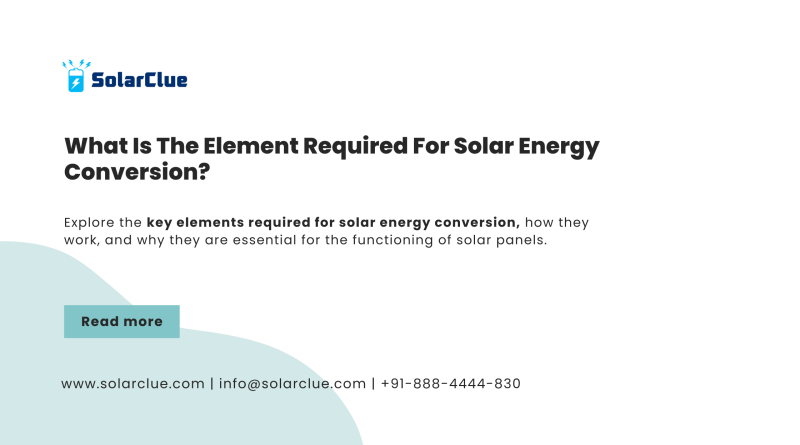What Is The Element Required For Solar Energy Conversion?
Solar energy conversion is a fascinating process that involves transforming sunlight into usable energy, primarily electricity. This process is made possible by specific elements and materials that possess unique properties allowing them to capture sunlight and convert it into electrical power. In this blog, we will explore the key elements required for solar energy conversion, how they work, and why they are essential for the functioning of solar panels.
Table of Contents
The Basics of Solar Energy Conversion
Solar energy conversion typically occurs in solar photovoltaic (PV) cells, which are the building blocks of solar panels. These cells convert sunlight directly into electricity through the photovoltaic effect. To understand this process, it’s crucial to know about the elements that make it all possible.
Key Elements in Solar Energy Conversion
1. Silicon (Si):
Role: Silicon is the most widely used element in solar cells. It is a semiconductor, which means it can conduct electricity under certain conditions, making it ideal for capturing and converting sunlight into electricity.
How It Works: When sunlight strikes the silicon in a solar cell, it knocks electrons loose from the atoms in the silicon. These free electrons then flow through the material, generating an electric current.
2. Phosphorus (P):
Role: Phosphorus is used to dope the silicon in solar cells, meaning it is added in small amounts to create an excess of electrons. This forms what is known as an n-type (negative) semiconductor.
How It Works: The addition of phosphorus to silicon creates free electrons that are available to conduct electricity when the silicon is exposed to sunlight.
3. Boron (B):
Role: Boron is used to dope the silicon in a different way, creating a p-type (positive) semiconductor by creating “holes” (the absence of electrons) in the silicon structure.
How It Works: The combination of n-type silicon (doped with phosphorus) and p-type silicon (doped with boron) creates a junction where the flow of electrons can be controlled to generate electricity.
4. Aluminum (Al):
Role: Aluminum is often used as a back-surface field (BSF) in solar cells to reflect sunlight back into the cell and improve efficiency.
How It Works: Aluminum layers help to capture more light and increase the chances of converting that light into electrical energy by reflecting it back through the silicon.
5. Cadmium Telluride (CdTe):
Role: Used in thin-film solar cells, cadmium telluride is a compound semiconductor that can efficiently convert sunlight into electricity.
How It Works: CdTe solar cells have a simple, cost-effective structure and are effective at converting sunlight into electricity, particularly in areas with high temperatures.
6. Copper Indium Gallium Selenide (CIGS):
Role: CIGS is another material used in thin-film solar cells. It offers a higher efficiency compared to other thin-film materials.
How It Works: CIGS cells use a mixture of copper, indium, gallium, and selenium to absorb sunlight and generate electricity. They are flexible and can be used in a variety of applications.
7. Indium Tin Oxide (ITO):
Role: ITO is used as a transparent conductive coating on the top layer of some solar cells.
How It Works: It allows sunlight to pass through to the active layer while also conducting the electricity generated by the solar cell.
8. Gallium Arsenide (GaAs):
Role: Gallium arsenide is a semiconductor used in high-efficiency solar cells, particularly in space applications.
How It Works: GaAs cells have a high absorption coefficient and can convert a broad spectrum of sunlight into electricity, making them more efficient than silicon in certain conditions.
Key Elements in Solar Energy Conversion
| Element/Compound | Role in Solar Energy Conversion | Type of Solar Cell Used In |
|---|---|---|
| Silicon (Si) | Semiconductor; generates electricity from sunlight | Monocrystalline, Polycrystalline PV Cells |
| Phosphorus (P) | Doping agent; creates n-type semiconductor | Silicon-based PV Cells |
| Boron (B) | Doping agent; creates p-type semiconductor | Silicon-based PV Cells |
| Aluminum (Al) | Reflective layer; improves light capture and efficiency | Silicon-based PV Cells |
| Cadmium Telluride (CdTe) | Semiconductor; absorbs sunlight and generates electricity | Thin-Film Solar Cells |
| Copper Indium Gallium Selenide (CIGS) | Semiconductor; converts sunlight to electricity | Thin-Film Solar Cells |
| Indium Tin Oxide (ITO) | Transparent conductive coating | Various, including thin-film cells |
| Gallium Arsenide (GaAs) | High-efficiency semiconductor; converts sunlight efficiently | High-Efficiency and Space Applications |
Conclusion
Solar energy conversion is made possible by a variety of elements, each playing a crucial role in capturing sunlight and converting it into electricity. From the widely used silicon in photovoltaic cells to the advanced materials like gallium arsenide used in high-efficiency applications, these elements form the foundation of solar energy technology. Understanding these elements and their roles helps us appreciate the complexity and innovation behind solar panels and the critical role they play in our transition to renewable energy.
Interested in understanding the key elements required for solar energy conversion? Harnessing solar power effectively involves crucial components like photovoltaic cells and semiconductors. To dive deeper into the technology behind solar energy and how it can benefit your home or business, visit SolarClue. Our experts will help you explore the best solar solutions tailored to your needs. Start your journey to clean, efficient energy conversion with SolarClue today!



